Linea "C" - Costa Cruises S.S. Frederico C 1958–1983, to
become the S.S. StarShip Royale - 1983–1988 & S.S. SeaBreeze -
1988–2000
Please Note: Firefox and some other Search Engines may not be suitable
Use Google Chrome for this Web Page to load perfectly!
Please Note: All ssMaritime and other related maritime sites are 100% non-commercial and privately owned, thus ssmaritime is NOT associated with any shipping company or any other organisation! Although the author has worked and been involved in the passenger shipping industry for well over 60 years, but due to his old age and poor health, he was forced to retire. Yet, he has completed well over 1,355 Classic Liners, Passenger-Cargo Liners as well as humble converted C3 converted Migrant Liners, which has transported countless thousands folk to the new world, as well on vacations’. I trust the features online will continue to provide Classic Liner and Ship enthusiasts both the information they are seeking, but more so provide a great deal of pleasure and relive many happy memories!
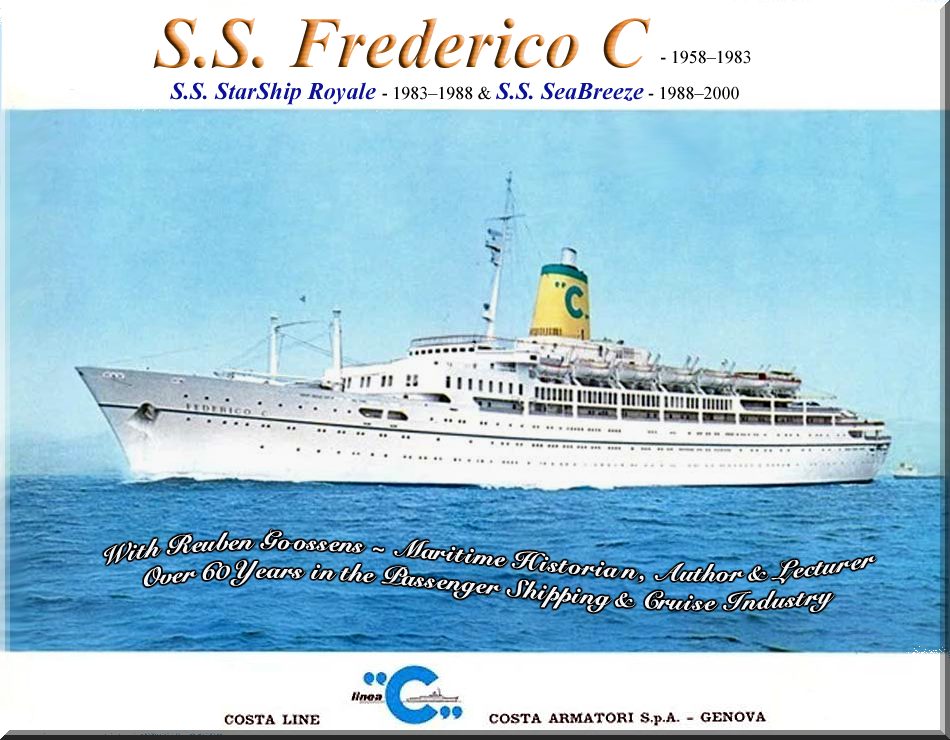
The
Please
Note: Postcards, photographs & other images are
from the author’s private collection, unless stated otherwise.
A special thank you to
This feature covers a Costa Line Flagship, the wonderful S.S. Frederico C a liner that became a greatly loved cruise ship that sailed on for 42 years, but having been sold she has a several name changes. This is her story and I trust that will enjoy the journey with her!
Linea “C” - Costa Line:
A new shipping company was founded in 1854 by
Giacomo Costa as “Giacomo Costa fu
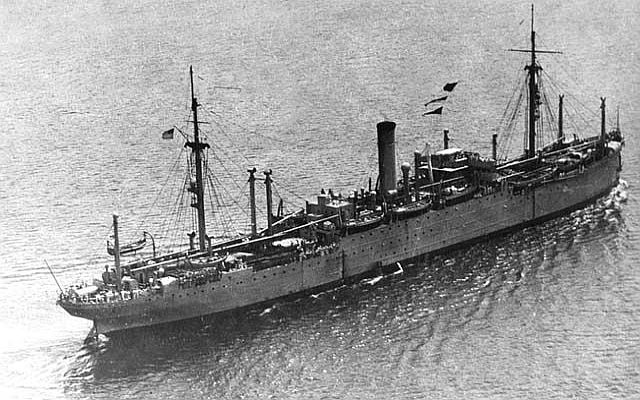 -
-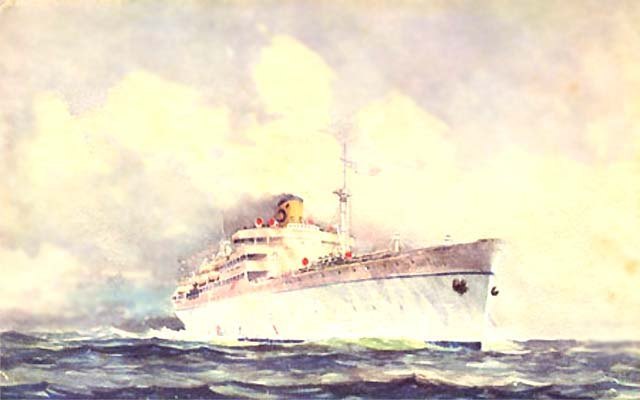
The
Linea “C” first true passenger
ship was the 11,736
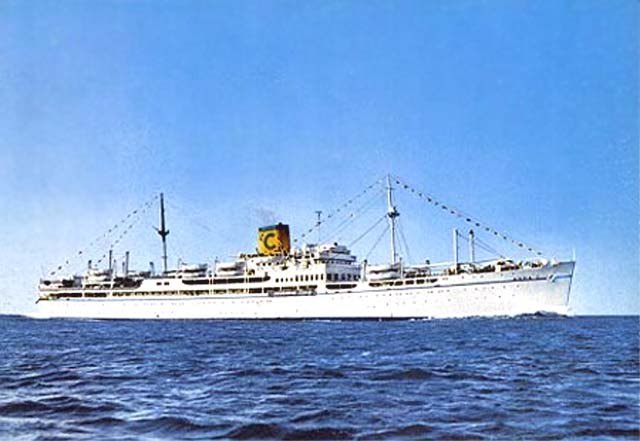
The delightful
motor ship
In 1959, Linea “C” gradually
commenced offering some pleasure cruises, with voyages being offered in
the Mediterranean as well as the
In 1986, Linea “C” changed its name to “Costa Cruises” and became a full time Cruise Company.
Costa’s
Linea “C” S.S.
Frederico C

Costa’s
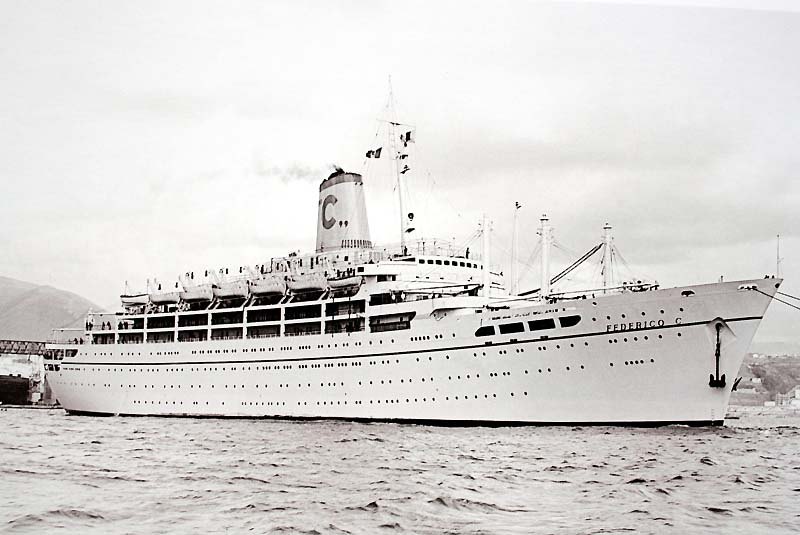
Linea
“C” first brand new built ship, the
Even though there was an anticipation of a
decline in passenger and migrant services to South America due to the ever
increasing air travel Linea “C” decided they needed a brand new
superior, high quality ship in order to strengthen their share in both First
and Tourist Class passenger service to and from
The Italian shipyard chosen was “Ansaldo G. & Co” or “
Her keel was laid down on June 9, 1956 as Hull
N° 1516, and she was ready for her launching it was a huge affair for post-war

Above &
below: The launching of the
Photographs by “Ansaldo G. & Co” Shipyard
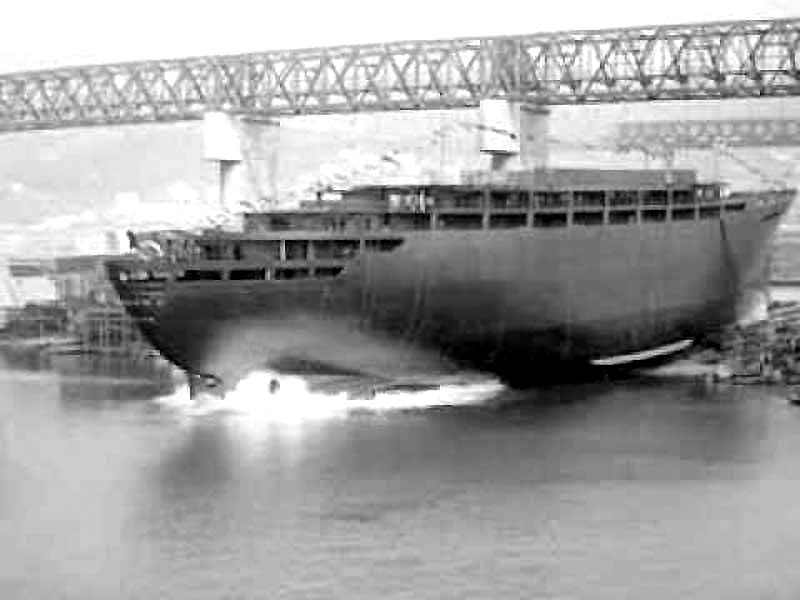
Once she entered the water she was towed to Ansado’s fit-out quay where her interiors and exteriors were completed, with some of the finest interior decorators used to install her fine lounges as well as her staterooms and cabins.
One completed she undertook her deep sea and speed trials from 21 to 23 February 1958 and she reached a respectable top speed of 22.3 knots. Once she had successfully completed her trials, she returned to the fit-out berth, then back into dry-dock for her final paint touch up’s, before being delivered to her owners.
On March 14, 1958, the
The
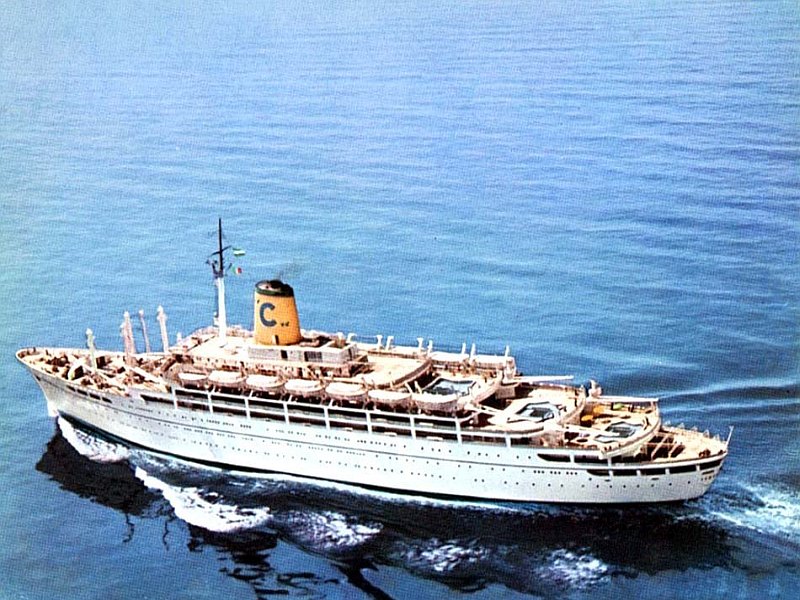
An aerial postcard
of the
Note her three aft stylish swimming pools
The Ship and her Facilities:
The elegant looking Linea C’s new flagship; S.S. Federico C was built to be a stylish three class liner First, Cabin and Tourist Class, and she was Costa’s very first ship to be especially constructed for them. When people saw her for the very first time they were amazed at her style, as she was a shapely and a beautiful looking liner!
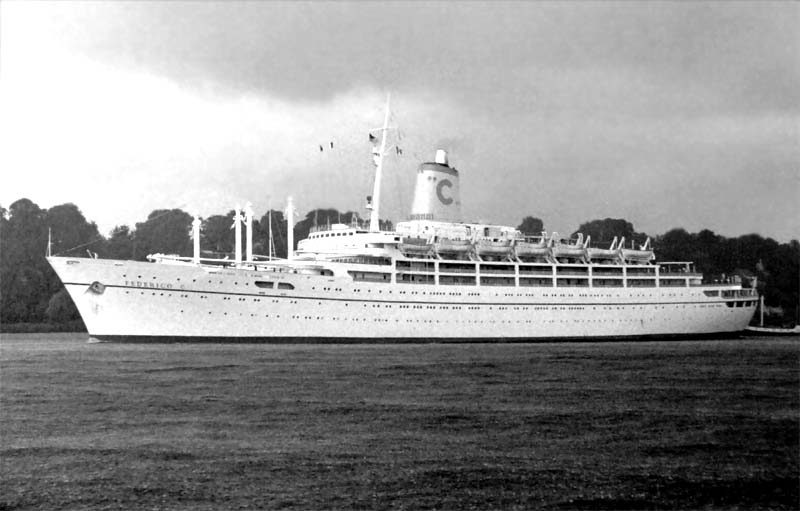
A fine photograph
of the
Provided by
She had an all white livery with a blue ribbon
surrounding her hull and a shapely modern yellow funnel with the Companies blue
“C” logo and blue top. She certainly was an attractive ship and she
became famed for her luxurious interiors. She was fully air-conditioned, and
the very first liner on the
Costa Line had selected the very best Architect and interior designer ‘Nino Zoncada’ who ensured that this ship would be truly magnificent in every possible respect! He took great care with her décor as her Public Rooms and Accommodations, which were based on typical contemporary Italian style, and featured a restrained use of colours. First Class was magnificent; however Second Class contained very much the same luxuries as found in First Class.
She offered her passengers eight decks, commencing topside with decks named as follows; Bridge, Sun, Lounge, Promenade, Restaurant, Main, A and B Decks.
Bridge Deck:
Commencing forward was the Bridge, followed by officer’s quarters, and aft was the Radio Room and Children’s Play Room on the starboard side. This was followed by a spacious sports deck.
Sun Deck:
Offered a range of First Class cabins commencing forward and along the starboard side, whilst aft of the superstructure was the delightful Pool Lounge. The latter was followed by yet another spacious deck with and attractive and a shapely Pool. Both Restaurants are identical, as it is the same venue, but is separated by a partition to suit any variation.
Lounge Deck:
Forward we find the spacious First Class Ballroom, followed by the Lobby and grand stairwell and two lifts. As we head aft we find the relaxing Main Lounge and Library and Reading Room. Out side on both sides and is the First Class Promenade Deck that goes half way of the length of this deck, for aft was Cabin Class, which was as good as First Class.
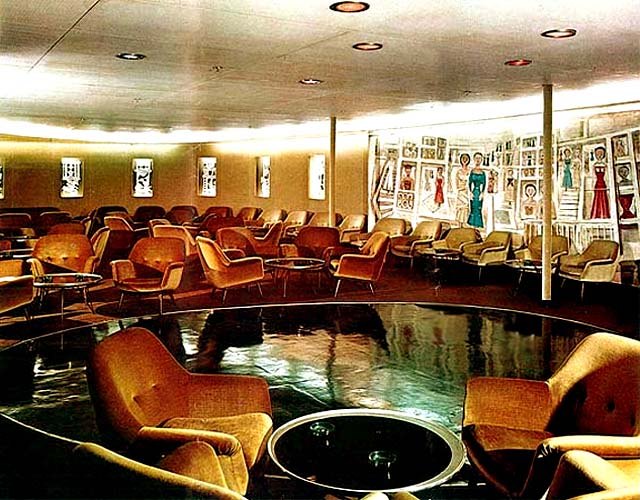
The First Class Ballroom
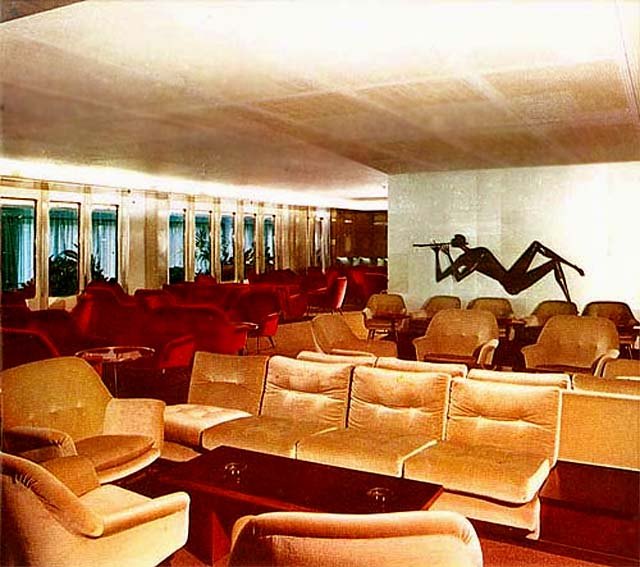
Main Lounge, the
sculpture of the bronze Flute Player was by
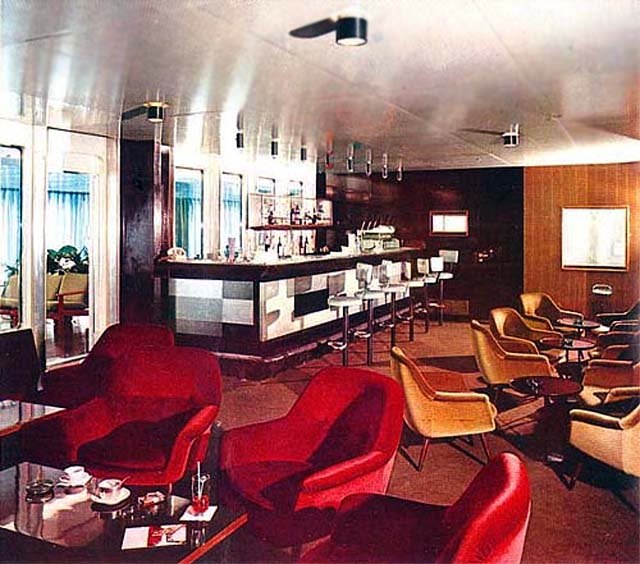
First Class Lounge and Bar
Amidships is the Cabin Class Lobby which was followed by the huge Venezia Lounge. Aft there was another Pool lounge and the Cabin Class pool. Of course along the sides is the continuation of the Promenade that goes to far aft.
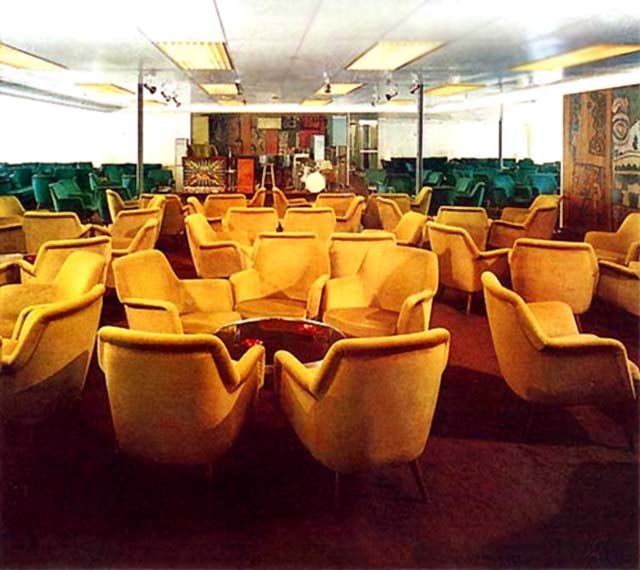
The Cabin Class’ Venezia Lounge
Promenade Deck:
From forward to amidships, were the First Class Staterooms and Cabins with a fine lobby.
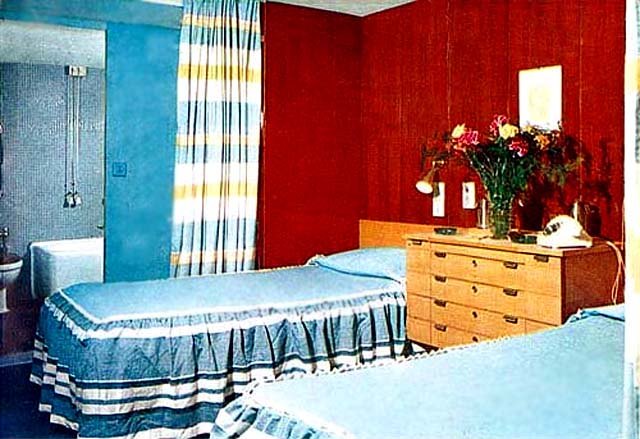
First Class Stateroom

A First Class Twin bedded Cabin
Aft were both Cabin Class and some Tourist Class Cabins with the Tourist Class Poolside Lounge at the stern of the superstructure, and another specious deck outside with the Tourist Class Pool.

A Cabin Class outside Twin Bedded Cabin
Restaurant Deck:
This Deck contains a Cinema far forward, followed by some cabins, the Main Lobby with the Pursers Office, followed by one huge Restaurant. This venue is divided, the forward section being First Class and the aft part was Cabin Class. Public spaces for both classes were very much the same, offering much the same style and décor. In fact Cabin Class would be like First Class on other liners, if they were lucky!
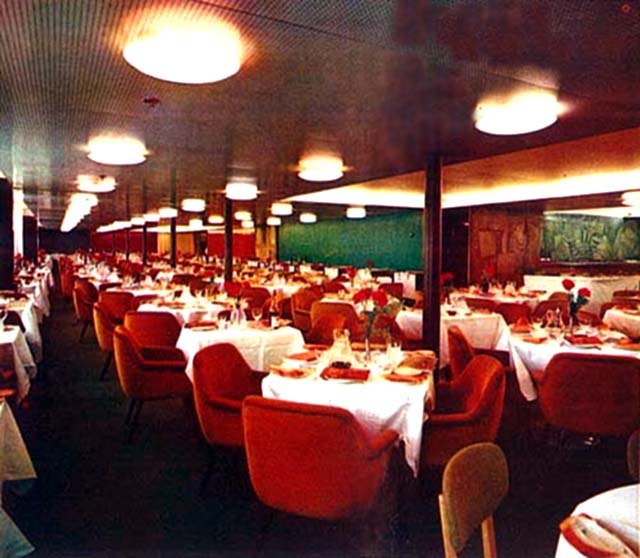
First Class Restaurant

The Cabin Class Restaurant
Aft was the aft Lobby and followed by further
Cabins. Many cabins on the
Main Deck:
Forward there were more Tourist Class Cabins, as well as several public venues that included the Orvieto Lounge and their Restaurant.
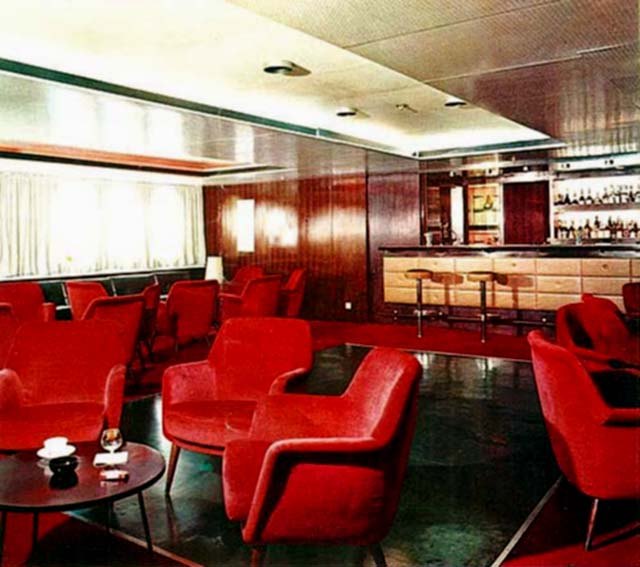
The Tourist Class delightful Orvieto Lounge and Bar
However far aft there were further Cabin Class accommodations, as well as the Firenze Lounge.

The delightful Cabin Class Firenze Lounge
A and B Decks:
These decks contained both Cabin and Tourist Class accommodations, as well as some other facilities, such as the Doctors Surgery, etc.
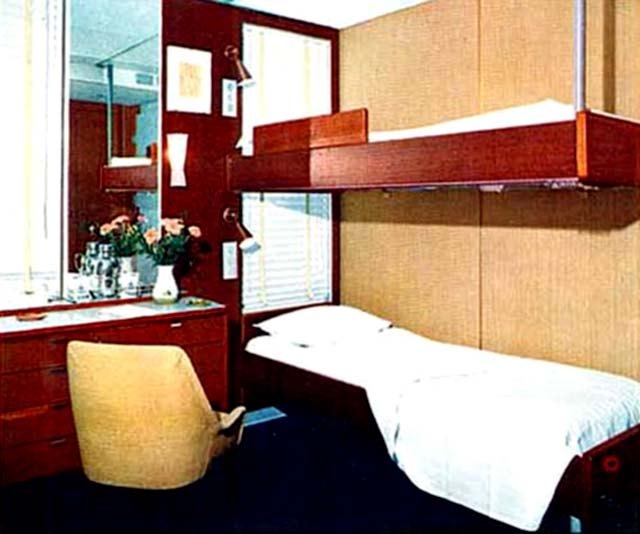
A Two Berth Cabin
Class Cabin on A & B Decks
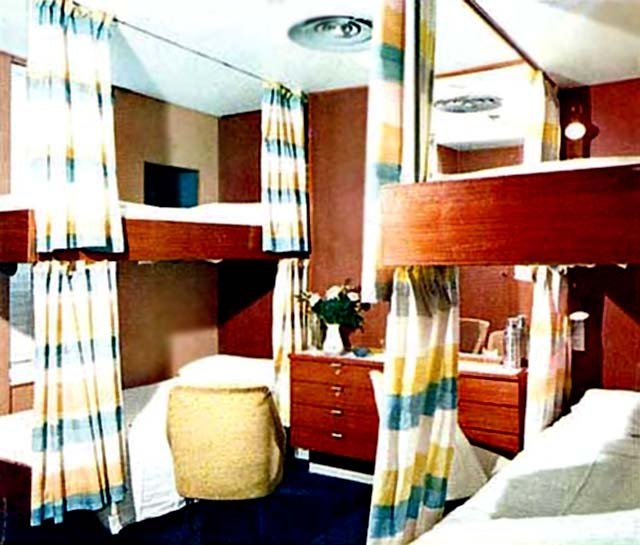
A Tourist Class Four Berth Cabin and as can be seen it was of an excellent standard
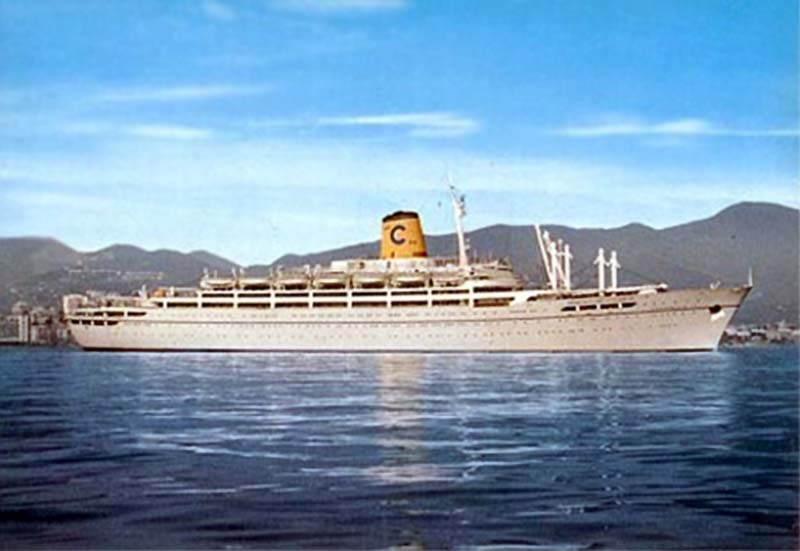
A fine postcard of
the
Schedules:
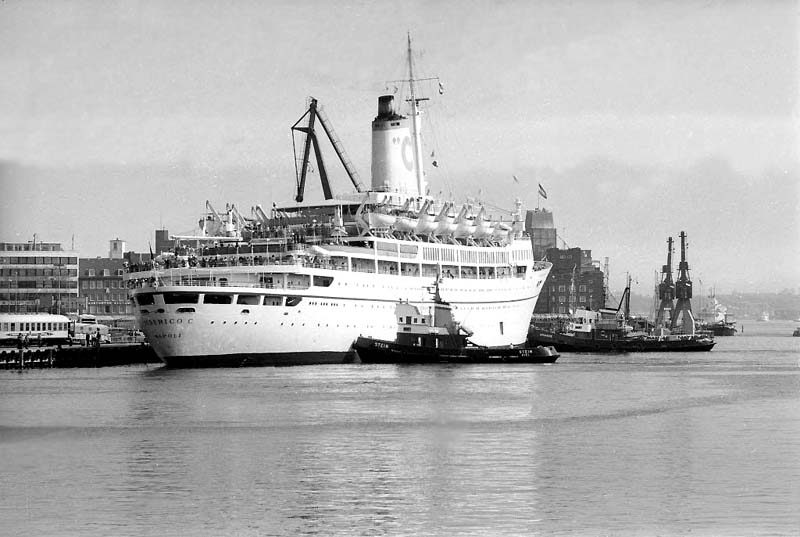
Photo by Provided
by
The
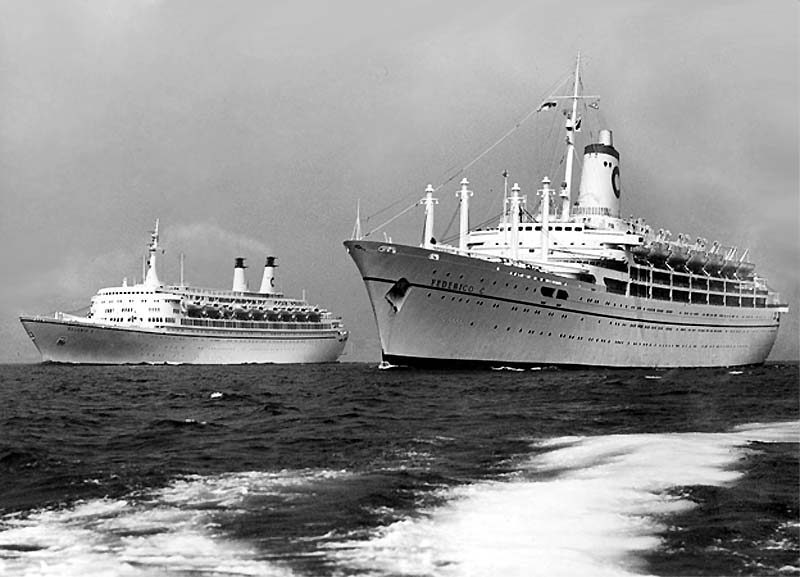
Here we see both the
new
The 1966 Sailing Schedule below shows that the
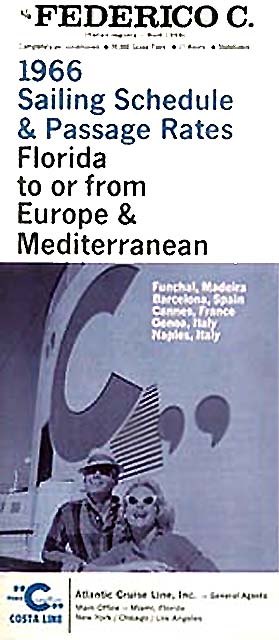
S.S. Federico C continued on the new service as well as winter cruises, but it was decided that ten years after her maiden voyage it was time to give her a comprehensive refit as she needed new and upgraded facilities, meeting the demand of demanding passengers, as her standards had to be very high!
Thus she was sent to the Mariotti Shipyards in Genoa, where work commenced in May 1968 and her refit saw the Frederico C change dramatically externally as was about to become a part time liner and a cruise ship during the northern hemisphere winter.
Her Promenade Deck was glazed in as far as the ships last two lifeboats up on Boat Deck. In addition her superstructure was stretched forward to build some new more spacious cabins. Her new passenger configuration was now 186 in First Class and 1,450 in the new Tourist Class, although during cruises she would carry just 1,259 passengers. The refit also saw the removal of hold N°3 and the relevant cargo derricks.
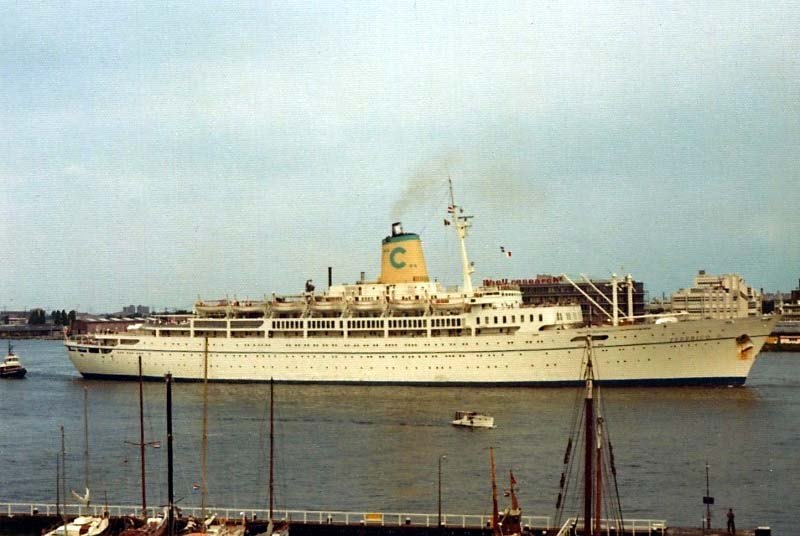
The new look
Photograph © by
Upon completion she looked like a brand new
ship and although her schedule remained very much the same, but Caribbean
cruises were added between her regular liner voyages. However during cruises,
this two-class ship would become a One Class cruise ship for 1,259 passengers.
In 1972 the
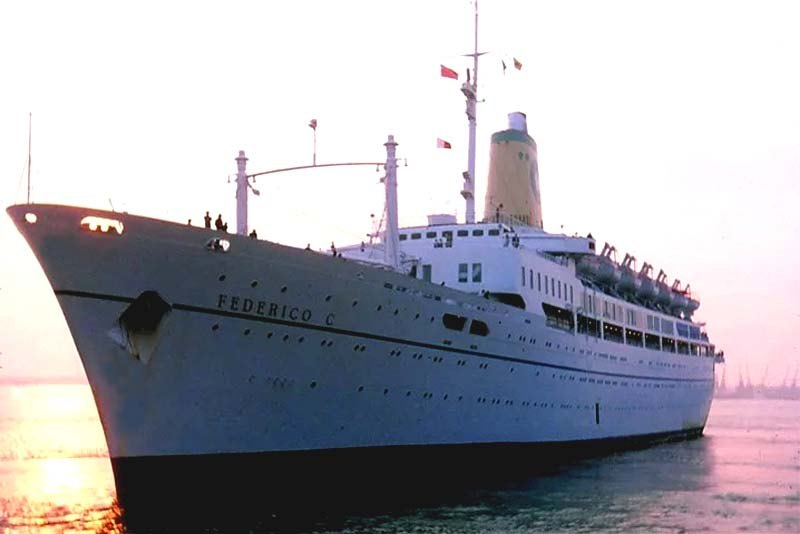
Photo by Provided
by
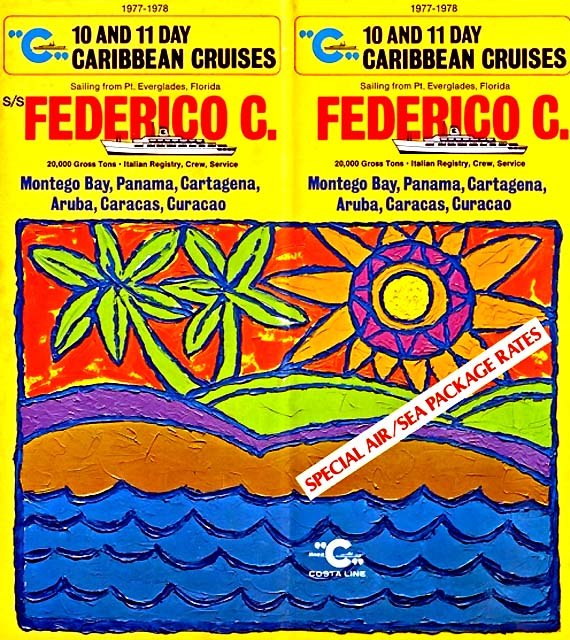
Above & below:
An 1977/1978 cruise brochure

During the winter of 1976 & 1977 there were further upgrades to her interiors, then in September 1980 she was fully refurbished, making a beautiful ship even more luxurious.
However with the newer ships in the fleet
Costa had made their decision, and when she returned to
S.S. Frederico
C
On November 29, 1983

Premier Cruise
Line logo
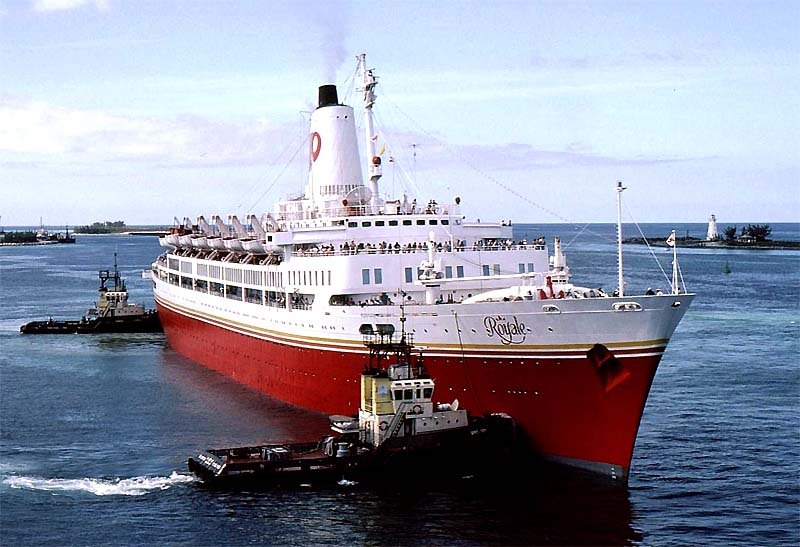
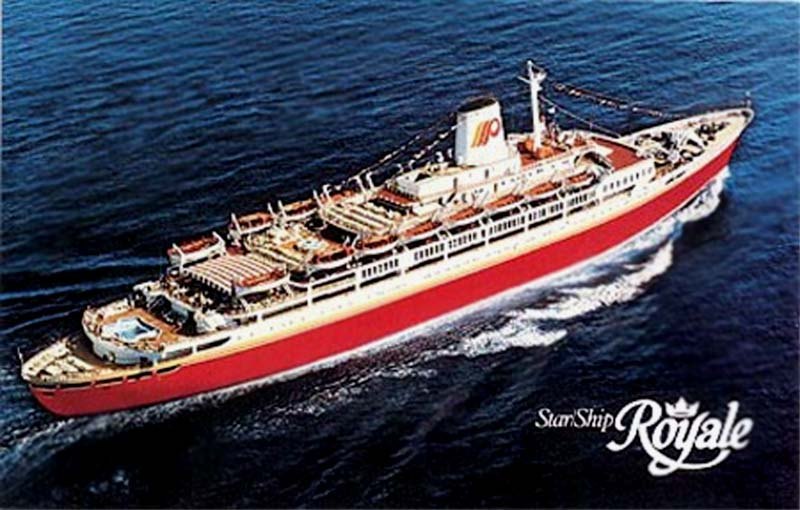
Here we
see her as the “StarShip Royale”
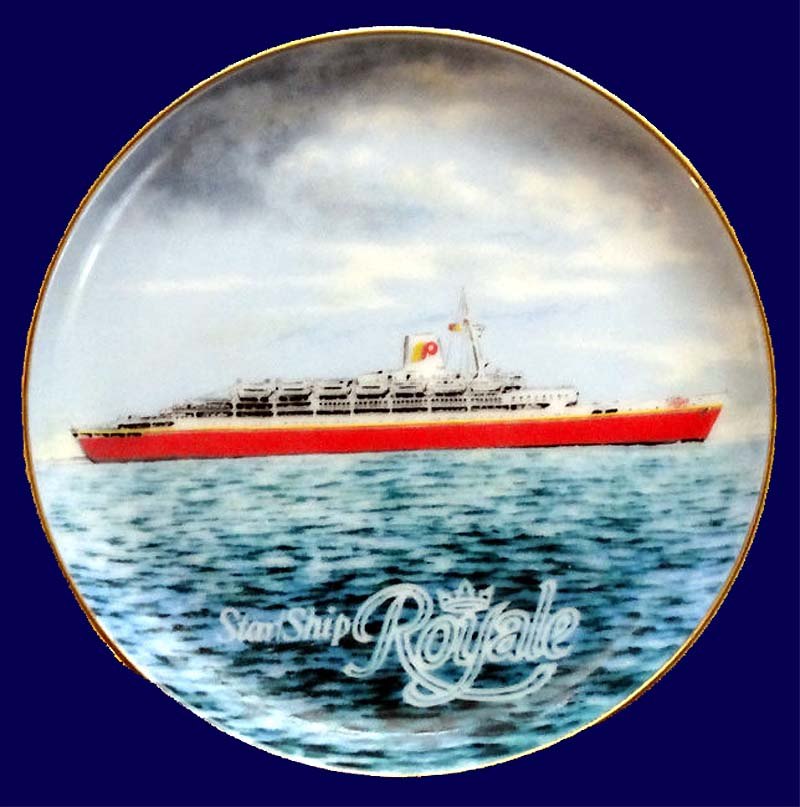
A souvenir
StarShip Royale sold again:
Having obtained quite a sizable fleet of ships, Premier decided to sell the “StarShip Royale” and a Greek Company Dolphin Cruise Line obtained her, and she was delivered to them on January 2, 1989, and she was renamed “SeaBreeze I”.
She received another refit with her hull being painted white again, but with three ugly racing stripes stupidly pointed down to the waterline at her bow. Her funnel now had a blue jumping Dolphin logo.
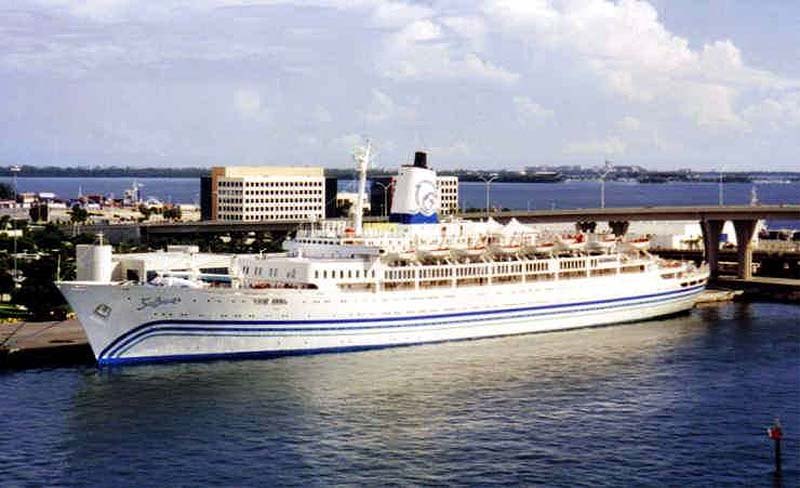
On completion, she was based in
However, somehow in 1997 the ship was returned to Premier as they had taken possession of SeaBreeze I when they acquired Dolphin Cruise Line. She once again had her hull repainted, as she would now have a new, handsome livery, a dark blue hull with gold accents, being an improvement on that red hull, that with those silly stripes.
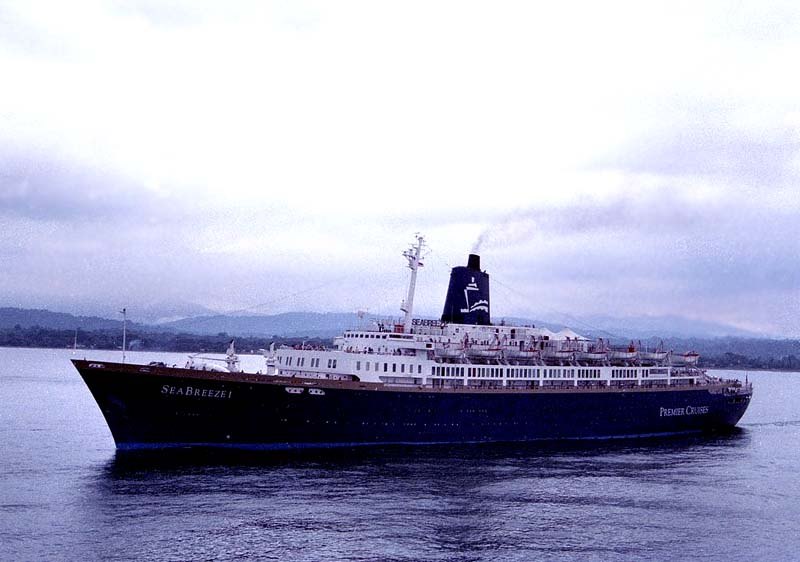
Premier’s
Photograph © by
The SeaBreeze I was 21,900 GRT and was
registered in the
In 1999 Premier Cruise Line released a new
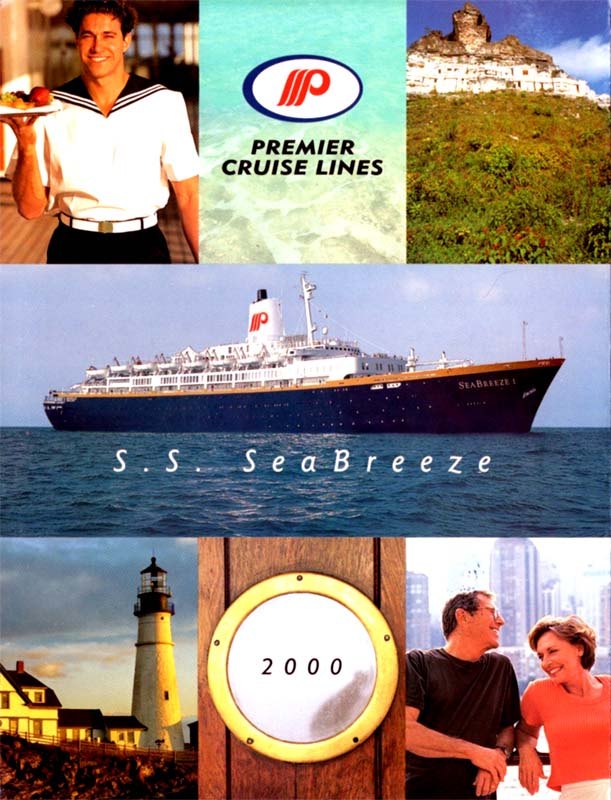
The final Premier
brochure for the
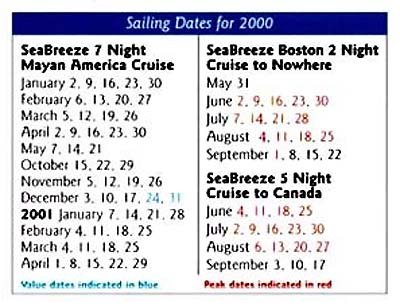
Below, the final
photographs of the SeaBreeze interiors
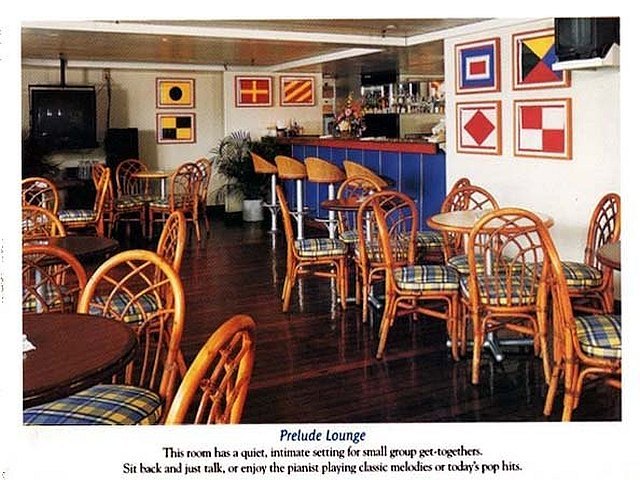
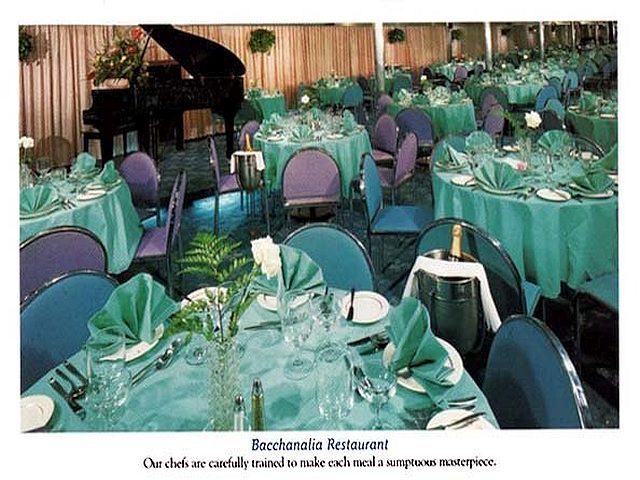
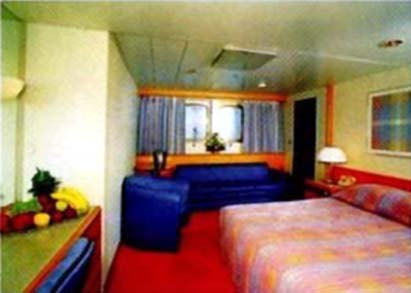 -
- -
-
Left to right: A Suite, Ocean View Stateroom and an Inside Twin Bedded Cabin
The End is Near:
Sadly Premier went out of business in
September 2000, and the ship was ordered to cease operations whilst she was
docked at
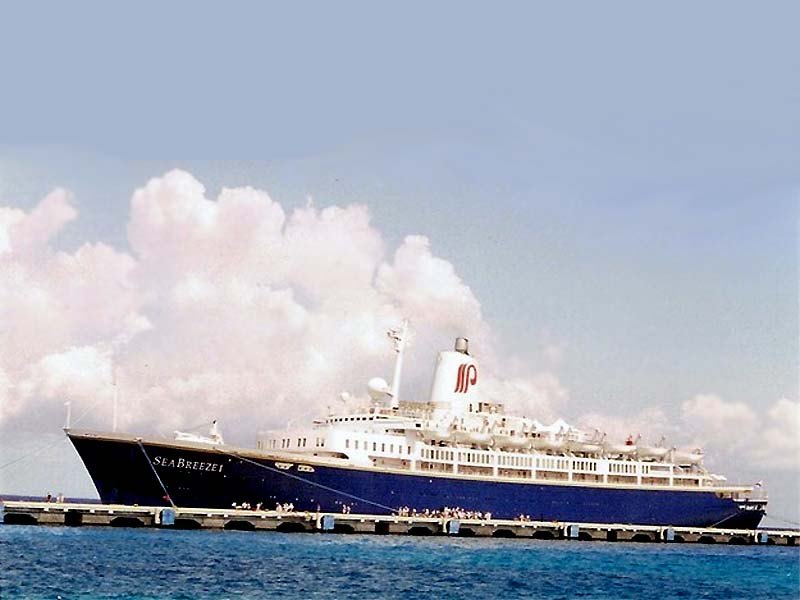
One of the last photographs taken, whilst she was in Lay-up
On September 14, 2000, the ship was placed
under arrest as she was berthed in
On December 1, 2000, the creditor’s bank purchased her at auction; Then on December 15, 2000, she sailed from Halifax bound for Charleston; however she went down on December 17, during a storm around 200 miles East of “Cape Charles.” It was claimed that the boiler allegedly broke off and damaged the ship, but there is really a very big is that true? Thankfully her 34 crewmembers were rescued by U.S. Coast Guard helicopters and of course there were no passengers onboard.
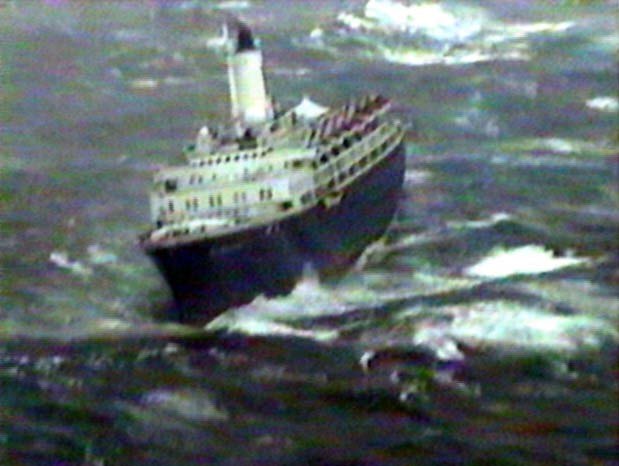
The SeaBreeze I seen here about to sink
The investigation in regard the sinking
of SeaBreeze I caused huge international concern, this was based upon
a number of suspicious incidents, including the fact that the SeaBreeze I would
only have fetched between US$5 and $6 million for scrap, but her
owners had placed a massive US$20 million insurance policy on her. The
ship's captain had very quickly radioed a distress call stating that he was
down to one engine & was taking on water. She sank in international waters,
and was flying the Panamanian flag at that time, thus making
The ship's captain told the United States Coast Guard rescuers that his ship was in imminent danger of sinking as a result of its engine room being flooded in high winds and 25-foot (7.6 m) seas. At the time, the Coast Guard rescuers believed that it was highly unlikely for a large 21.000 ton ship to sink that fast, and they were astonished when the Greek captain demanded that all hands be extracted from the ship as soon as possible, rather then requesting salvage tugs and tow her to shore for recovery.
The truth is that
The wonderful
Please Note: Page Two (Index below) contains her various Deck Plans as well as a complete list of the Ships Specifications and General Details.
*************************
Remembering
the magnificent -
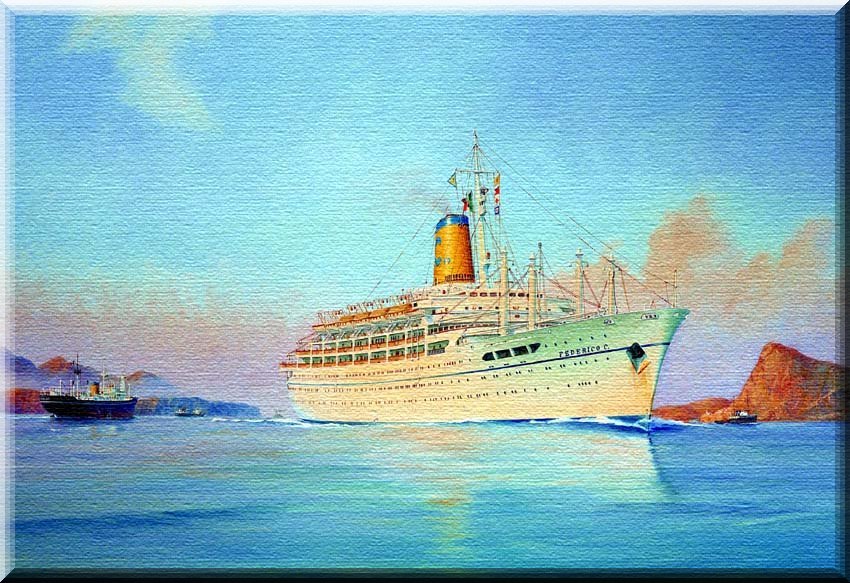
A fine artist’s impression of the magnificent Linea “C” - S.S. Federico C
By an unknown painter
Page One:
Page Two: Deck Plans & General Specifications.
Page Three: Costa’s
*************************
“Blue Water Liners sailing to the distant shores.
I watched them come, I watched them go and I watched them
die.”
Featuring over 1,358 Classic Passenger Liners, Passenger-Cargo Liners & Classic Cruise Ships!
Or ENTER HERE
For interest:
Sadly an email service to ssMaritime is no longer available, due to the
author’s old age and chronic illness as well as being disabled, etc. In
the past ssMaritime received well over 120 emails per day, but
**************************
ssMaritime.com & ssMaritime.net
Where the ships of the past make history & the 1914 built M.S. Doulos Story.
The Author has been in Passenger Shipping & the Cruise Industry for well over 60 years
In addition he was the founder of “Save the Classic Liners Campaign” in 1990.
Please Note: ssmaritime and associated sites are 100% non-commercial and the author seeks no funding or favours of any shape or form, never have and never will!
Photographs on ssmaritime and associate pages are by; the author or from the author’s private collection. In addition there are some images that have been provided by Shipping Companies and private photographers or collectors. Credit is given to all contributors. However, there are some photographs provided to me without details regarding the photographer/owner concerned.
This notice covers all pages; although, and I have done my best to ensure that all photographs are duly credited and that this notice is displaced on each page, that is, when a page is updated!
ssMaritime is
owned & © Copyright by

